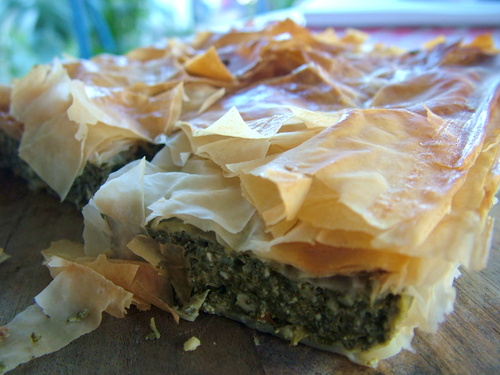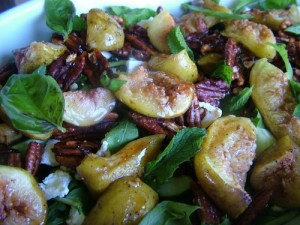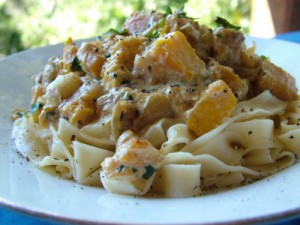The silver beet was getting smashed for a few weeks, I think by cluster caterpillars, then suddenly it wasn’t. It looked so gorgeous this morning, and the patch needed thinning. And the basket just filled and filled.

There was some feta in the fridge, I was almost certain. And some left over filo pastry in the freezer. The chooks are into the spring flush of eggs, so many we give several dozen a week away. Spankakopika it has to be. Greens, eggs, feta, filo, butter or oil. All the rest is optional.
The Recipe:
You need leafy greens, lots of them, and it doesn’t much matter what kind. I base it around silver beet or spinach, but after that it’s whatever you have, whatever you like, whatever combination you feel like experimenting with.
Today’s recipe was silver beet (probably the equivalent of two big bunches?), with small bunch each of rocket, parsley, radish leaves, kale, nasturtium leaves, dandelion leaves. But last week’s recipe combined the silver beet with English spinach, spring onion, and a small bunch of mint, and other times I’ve added sorrel, mustard greens, endive, dill, fennel, lemon basil, tarragon …
Wash the leaves and blanch them in a pressure cooker, (or a pot with a tight lid), for just a couple of minutes to wilt them, then pour into a colander and squeeze with a potato masher to drain well.
Keep a little bit of beaten egg aside to glaze the top with later. Into the food processor, along with eggs (I used half a dozen because I have excess, but 3 or 4 would do), feta cheese, and, well, here again it gets optional.
I added the juice of a lemon, four cloves of garlic (crushed), the end of a block of parmesan and the last of a tub of Greek yoghurt.
Last week I added just a few spoonfuls of cottage cheese – it had spring onions in the greens and I thought the mint might work better without lemon. Other times I’ve added ricotta instead of the yoghurt, a bit of cheddar in place of the parmesan (or left it out entirely), some red onion instead of the garlic, preserved lemon (or lemony leaves) instead of fresh. The feta makes it salty enough but you may like to add some black pepper, or leave it out if you’ve used peppery leaves.
Ok, here it gets optional again. You need to brush each layer of filo with oil. I like a mixture of melted butter and olive oil, but whatever you have, whatever you like. You will use a bit of it though, so make it a nice tasting oil.
Now is a good time to turn the oven on to heat up. You need a medium oven, 180°C.
Brush a baking tray with oil, spread a sheet of filo in it, brush with oil, add another sheet. You will need filo at least 4 or 5 sheets deep on the bottom and I like to use 6 or 8 if I have plenty. You want your filo up the sides of your baking tray. Depending on the shape and size of your baking tray, you may need to alternate the direction.
Pour the filling in and spread it evenly. It doesn’t much matter how thick it is – 30mm or so is ideal but thin is fine too, and thick is good if you had plenty of eggs in the filling (so it holds together when cut).
Lay a sheet of filo on top, brush with oil, and fold the sides down over it to seal it like a parcel. Brush with oil, add another sheet, and repeat. I like at least 6 layers deep on top. Brush the top with oil.
Use a sharp knife to score the top in a diamond pattern, then brush along each score with the beaten egg. This stops the top layer of filo from flaking right off as it gets crispy in the oven.
Bake for around 30 minutes till it is golden and crispy on top.
It’s good hot, with or without a side salad, but also good cold in a lunch box.




Yum. I do something similar when I have a bunch of beetroot – the leaves need to be steamed/sauteed for a little longer than silver beet – but because I’m too lazy to bother with brushing layers of filo, I use puff pastry.